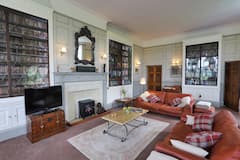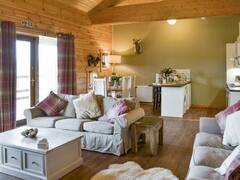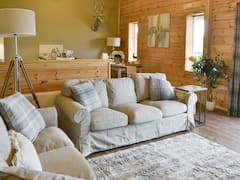Although one of the least visited parts of England, Northumberland, in the northeast of the country, has a spectacular coastline and more castles and historic sites than any other county in England.
The county’s coastline was voted the Holiday Destination of the Year in the BBC Countryfile Magazine Awards 2017, while one of its beaches, Embleton Bay, won Beach of the Year after a public poll.
Fine sandy beaches arc along the North Sea; spectacular castles stand guard on the shoreline and pretty villages and jolly pubs abound. Puffins and seals enthrall visitors on the Farne Islands. Every few miles there’s another castle to explore, some are just ruins now, but others are filled with fascinating treasures and some are even still family homes.
Awesome Alnwick Castle

Alnwick Castle is a fine fairytale of a castle situated in glorious Northumberland, the English county with the most castles per square mile. Alnwick Castle is the second largest inhabited castle in England (after Windsor Castle) and is home to the Duke and Duchess of Northumberland and their family. Ralph George Algernon Percy, is the12th Duke of Northumberland and was ranked at number 248 in the 2011 Sunday Times Rich List, with an estimated wealth of 400 million USD, or 300 million GBP
His wife, the Duchess of Northumberland is probably best known for redeveloping the Alnwick Garden, a large ornamental garden adjacent to the family seat, which is now a top tourist attraction in its own right. One particularly interesting feature of the garden is the ‘Poison Garden’, which hosts plants that are deadly poisonous but are also often used in medicine to cure. Their younger son, the dashing George Percy, is a sometime escort of one Pippa Middleton whose sister, Kate, recently married rather well. Their daughter, Lady Catherine, to be a bit different, shunned a life of meaningless socialising with the wealthy and worked as a motorcycle mechanic, racing driver and gunmaker.
Alnwick is such a perfect castle in appearance that it is much in demand as a film set and has featured in such Hollywood classics as Robin Hood Prince of Thieves. It also featured as a backdrop in Elizabeth starring Cate Blanchett, and in popular TV series such as Blackadder and Famous Five. One of the most well known uses of the dramatic views which Alnwick Castle offers, is its use as Hogwarts, the wizard school in the first two Harry Potter films.
Memorable scenes filmed there include the flying lesson in Harry Potter and The Philosopher’s Stone and the crash landing of the flying Ford Anglia in Harry Potter and The Chamber of Secrets. This is a big deal for Potter fans across the globe and there are Potter themed events throughout the year.
Dunstanburgh Castle

Dunstanburgh Castle, run by English Heritage, is just ruins now, but in its heyday it must have been a formidable fortress. Situated on the ‘Whin Sill’, which is a massive hard seam of igneous hardened magma formed many years ago, it now sits atop a sheer and impregnable rock face.
It was constructed by the powerful Thomas, Earl of Lancaster between 1313 and 1322. At the time, Thomas was the second richest man after the king. However, no one is quite sure why he built it. It could have been as retreat from the violent North South civil wars in England or just a very visible status symbol — after all who wouldn’t like their own castle if they could have one?
The castle was granted a ‘licence to crenellate’, which granted the holder permission to build fortifications and this makes it look more like a castle than the fort it was. Originally, the structure had a stone curtain wall, a massive gatehouse (still seen) and six towers round the outside. The castle subsequently passed to John of Gaunt who strengthened it against the Scots and it was the focus of fierce fighting during the Wars of the Roses, twice besieged and captured by Yorkist forces. Things are a lot more peaceful up there these days.
Northumberland is a part of the UK which has a turbulent past, experiencing occupations by both the Romans and the Vikings at different times in history. Dunstanburgh Castle is set high on a hill overlooking the North Sea. Nearby is the village of Craster, a fishing village famous for the family business of L. Robson and Sons who still smoke the herrings landed here in the traditional way over fires of oak sawdust.
Craster kippers have been treated this way for over a hundred years and are exported internationally. The pub in Craster, the Jolly Fisherman, specialises in local seafood dishes, and their cream of crab soup comes highly recommended. The walk along the cliff top from Craster Village to the castle is a very popular one, with fine views looking out over the chilly North Sea.
Chillingham Castle

Chillingham Castle is quite simply not like any other castle/visitor attraction I have ever been to, anywhere. A grand building indeed, but it is also very much someone’s home. You are entering an environment with all the stuff and clutter of generations gone by laid around to touch and see. There are no glass cabinets and no ‘do not touch’ signs. Instead of ugly ornaments and dull family photos at weddings, there are tigers’ heads, dungeons with skeletons, ancient artifacts from around the world and even a pair of antlers from the largest elk that ever lived. Not to mention at least four genuine ghosts!
At first a 12th century stronghold, Chillingham became a fully fortified castle in 1344 with a turbulent history as it fought back the Scots from the English border. The family were made dukes and earls in their early warrior days and are mentioned in Shakespeare’s historical plays. They were a part of the famous Grey family of Earl Grey tea fame. Of the many Grey commanding generals, eighteen were Knights of the Garter and royal appointments. On the down side, another eight of them were executed, invariably for high treason.
A visit to the torture chamber is not for the faint hearted. The instruments of torture here are real. There are some pretty gruesome exhibits including the stretching rack, the spiked wheel, the cage, the nailed barrel and the iron maiden, a kind of suspended metal cage. The castle was often in the throes of battle and conflict in more violent times gone by. Thumb screws, chains, leg irons and man traps are gruesome reminders of man’s inhumanity to man in times of trouble. The castle dungeon still has the scratched marks that captives made on the stone wall trying to count the days of imprisonment and possibly the coming of freedom. A trap door in the vault reveals the very genuine bones of a child, which were never buried. No wonder there are so many ghosts here. One ghost is apparently a former lady of Chillingham Castle whose husband ran off with her sister and appears quite regularly to visitors.
Another eccentric room is the ‘still’ room, dedicated to the Chillingham curse. A portrait of a Spanish witch hangs there who curses those who take anything from Chillingham uninvited. Some visitors did not heed the warning and some of their letters are on display. They have brought whatever they stole back to the castle in an effort to shake off the bad luck that has followed them around ever since. One letter reads 'Dear Sir Humphrey, please find enclosed item that was removed by mistake from your castle.’ The item in question is a large door knob.
Sir Humphry has led an adventurous life and his ancestors were great explorers and traveled all over the world.
There are interesting photographs of Mt. Everest and a striking portrait of Sir Humphry’s great uncle who made an early attempt on the summit, in 1922, dressed in only tweeds. There is the great sled of the explorer Norman Vaughan, and photographs of the great man himself, and his dog harness too.
Sir Humphry Wakefield’s family are originally from the Lake District and he came into the possession of Chillingham Castle by buying it from his wife’s brother. The Hon. Lady Wakefield is the daughter of the former Lady Mary Grey from nearby Howick Hall (hence the Earl Grey connection), and she is directly descended from the historic Chillingham family line.
You might be interested in these Airbnbs!
Northumberland: more castles than any other county in England
There are so many amazing castles to explore in Northumberland that it would take you weeks to see them all. Two favorites are the gorgeous Bamburgh Castle overlooking the sea and the famous Lindisfarne Castle where the vikings first landed in Britain, home of the venerable Bede and the Lindisfarne gospels.
The magnificent cross-shaped keep of Warkworth, crowning a hilltop rising steeply above the River Coquet, dominates one of the largest, strongest and most impressive fortresses in Northumberland. Its most famous owners were the Percy family, whose lion badge can be seen carved on many parts of their stronghold. The castle is still roofed and almost complete, and the uniquely-planned keep, dates mainly from the end of the 14th century. It now presides over the extensive remains of a great hall, chapel, fine gatehouse and a virtually intact circuit of towered walls.
If you love history and heritage, this part of England is a fantastic place to visit. With its stunning coastline and uncrowded countryside, Northumberland, land of castles, really is a hidden gem.
History
Get Trip101 in your inbox
Unsubscribe in one click. See our Privacy Policy for more information on how we use your data






















Create an account to